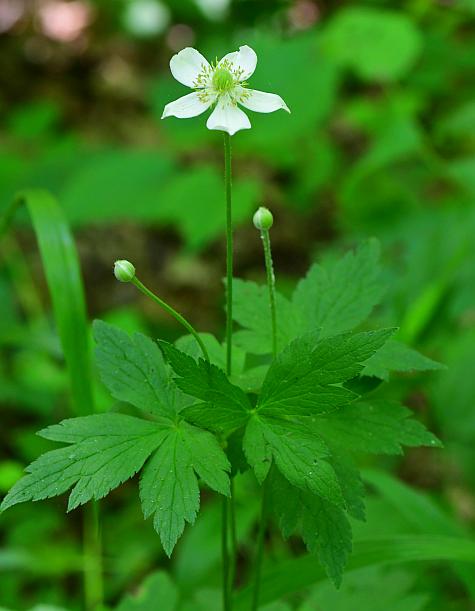Anemone virginiana L.
Thimbleweed

Native
CC = 4
CW = 3
MOC = 68
© SRTurner
Anemone virginiana L.Thimbleweed | |
 |
Native CC = 4 CW = 3 MOC = 68 |
© SRTurner |
|
Family - Ranunculaceae Habit - Rhizomatous perennial forb, from stout caudex. Stems - Erect, to 1 m, single from the base, sometimes branched, purplish near the base, pilose at base (hairs becoming dense and antrorse appressed on peduncles). Leaves - Basal leaves 1-8, long-petiolate, trifoliate. Petioles often purplish, to 20 cm long, hairy, with a shallow adaxial groove. Leaflets deeply lobed, the ultimate segments 12-26 mm wide, pubescent, rounded with a small sharp point or narrowed to a sharp or blunt point at the tip, the margins toothed.
Inflorescence - Each stem with 2 or 3 opposite whorls of 3 or 4 involucral bracts, the uppermost involucre positioned 11-42 cm below the flower, the bracts once-compound with 3 leaflets, short-petiolate but otherwise much resembling the basal leaves, the leaflets with stalks 9-64 mm long, lobed or parted and toothed, narrowed or tapered to a sharp point at the tip. Petioles of involucral bracts with a more distinct adaxial groove. Flowers 1-7 per stem on long, hairy peduncles.
Flowers - Sepals 5, petalloid, 7-21 mm long, 5 mm broad, white or greenish white, sericeous abaxially, glabrous adaxially, acute, with expanded margins near the apex. Margins often involute. Petals absent. Stamens numerous. Filaments glabrous, greenish-white, of varying lengths but the longest to 6 mm. Anthers yellow to greenish, 1.5 mm long. Pistils numerous, each with 1 ovule and 1 style. Receptacle cylindrical. Individual carpels green, pubescent at the base.
Fruits - Achenes, borne in cylindrical cluster, this less than twice as long as wide, to 3 cm long, 1 cm in diameter. Achenes obovate in outline, densely pubescent with woolly hairs concealing only the basal half, the beak 1-2 mm long. Receptacle elongated at fruiting.
Flowering - May - August. Habitat - Rocky and dry open woods and prairies, glades, savannas, ledges, bluff tops, rocky streambanks, roadsides. Origin - Native to the U.S. Lookalikes - Anemone cylindrica, Anemone quinquefolia (very rare in Missouri). Other info. - This species can be found throughout Missouri, as well as most of the eastern half of the U.S. The plant is very easy to ID when in flower or fruit because both are distinctive. A similar species, A. cylindrica, is found in the northwestern quarter of the state. This differs in having fruiting heads more than twice as long as wide, and also a greater number of bracts in the involucre. Missouri specimens of A. virginiana are classified as var. virginiana. Photographs taken at Alley Springs, MO., 6-3-03 and 6-27-03 (DETenaglia); also at Shaw Nature Reserve, Franklin County, MO, 6-15-2007 and 6-18-2011, Weldon Spring Conservation Area, St. Charles County, MO, 6-24-2011, and Poison Hollow, Howell County, MO, 6-11-2021, and Glassberg Conservation Area, Jefferson County, MO, 6-14-2021 (SRTurner). |